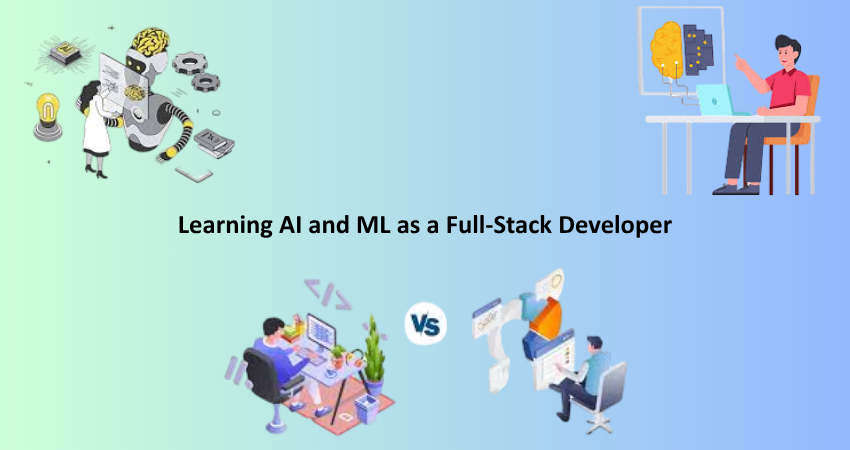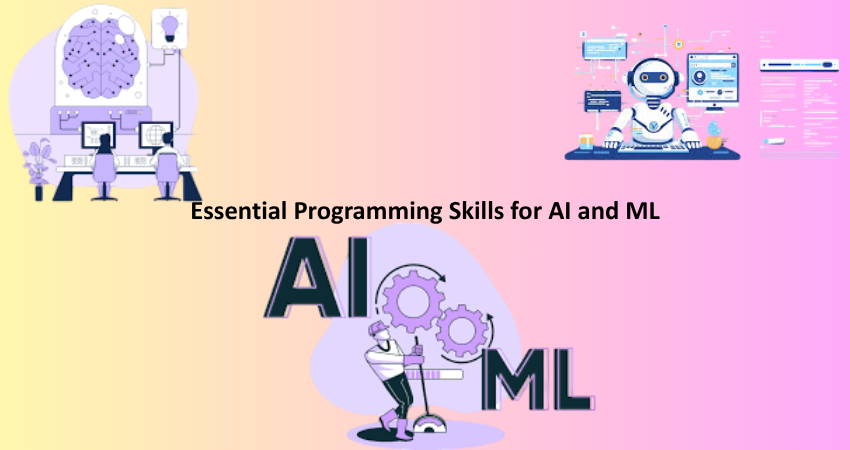
Introduction
Artificial intelligence and machine learning are revolutionizing industries across the entire technology landscape. Be it personalized recommendations on streaming services or awesome systems for fraud detection in banks; AI and ML are no longer optional—they are simply essential. Staying abreast in these fields will soon become critical for a full-stack developer. Usually, full-stack development would mostly mean front-end work and back-end systems. But now with AI and ML, this definition has also included parameters such as data science and predictive analytics. Indeed, these changes are going to enhance even more a developer’s skills and contribute to making such developers pricier in the job market, which is already established as having a premium on data-driven solutions.
Being a full stack developer gives you a better advantage for learning AI and ML because you understand all phases of the software development life cycle: UI design and user experience up to database and server-side programming. This makes it possible for you to integrate intelligent features into web and mobile applications. Both recommendation engines, chatbots, and predictive dashboards can be built with the use of the architectures and the algorithms. The report focuses on deep integration methods for full-stack developers towards AI and machine learning with the skills and tools required for this transition.
Understanding the Basics of AI and ML
What Is Artificial Intelligence?
AI is one of the major scientific areas of computer science dedicated to the making of systems that can mimic activities now performed almost exclusively by humans. Such activities include problem-solving, understanding natural language, learning, and making decisions. Indeed, AI systems will be defined as performing cognitive functions, designed to learn and improve performance by experience. It can be compared with traditional programming: In the case of traditional programming, rules are fixed in advance without any possibility of change; in the case of AI, however, rules are learned from patterns and then adapted. With this sort of system, one achieves such complex applications as intelligent virtual assistants, self-driving cars, and face recognition technologies.
With AI, we have subsets such as the most important one-Machine Learning. On the other hand, there are Natural Language Processing (NLP), Computer Vision, and Robotics. With the help of these sub-areas, large datasets, mathematical models, and high computing power, AI also draws intelligent decisions from its combination. The mentioned concepts become critical for full-stack developers because they are vital for the practical implementation following that. Developers who understand the basic differences between supervised, unsupervised, and reinforcement learning and key models such as decision trees, neural networks, and support vector machines will be able to catch up with building smarter, adaptive applications.
What Is Machine Learning?
Machine learning focuses on building algorithms that can learn from the data so that the machines could directly predict and take decisions without being programmed explicitly for every specific task. The process of learning from data includes training the models using historical data, finding the patterns generated from that data, and then taking those patterns into account when evaluating new incoming data. ML is especially useful in classification, regression, clustering, and recommendation systems. A few examples of applications in this area are spam filters, fraud detection systems, and recommendation engines, which are reliant on ML algorithms.
To successfully apply ML, full-stack developers need to understand the model training process, which includes collecting data, preprocessing, feature selection, model selection, training, validation, and deployment. Modeling applications are being built in these advanced frameworks, such as Scikit-learn, TensorFlow, and PyTorch. Rest API can be used to implement these ML models on the web application back-end and serve predictions to clients. This merger of your know-how in ML and development skill sets gives you a specialized edge to bring scaling opportunities to the dynamic and intelligent behavior of applications, thus increasing user value.
Essential Programming Skills for AI and ML

Python: The Core Language
Thanks to its simplicity and readability and an enormous support library ecosystem, Python is the most preferred programming language in the domain of AI and ML. Frameworks such as TensorFlow, Keras, scikit-learn, and PyTorch provide many built-in functions and models for helping users implement complex algorithms. Given your background as a full-stack developer, you might be acquainted with JavaScript as well as server-side languages such as Node.js or PHP. However, accepting Python will open gates for many. Python is a developer’s ideal option when it comes to data handling and AI libraries.
To get a grip on Python, you might generally need to know about syntax, object-oriented programming, and a set of main libraries for numerical and statistical computation. These should be the first few things you get started with. NumPy and pandas are cornerstones in manipulating and analyzing data. Jupyter Notebooks is one of the most popular interactive computing environments for Python programming, test, and debug ML models. Full-stack developers should, to a point, learn some Python for writing scripts and automation, as it helps in better efficiencies for building data pipelines. The addition of Python to the tech stack would only further provide you leverage regarding the tools to solve problems pertaining to AI and ML.
Math and Statistics Fundamentals
Thus, programming forms the foundation while mathematics is the language of AI and ML, and full-stack developers interested in these areas must build their understanding strong in linear algebra, probability, statistics, and calculus since they form the backbone of algorithms and model performance, affecting everything from how a model learns to how it generalizes to new data. These ideas such as gradient descent, matrix multiplications, as well as distributions of probability are important in debugging models to improve or fix their accuracies.
Statistics form the foundation with which data were built. For instance, mean, median, variance, standard deviation, correlation, and hypothesis testing are among the most basic concepts required for feature extraction as well as data preprocessing. Similarly, probability theory plays a critical role in classification problems, Bayesian methods, and decision-making under uncertainty. A firm footing in mathematics allows one to weigh model performance against any biases with immense capabilities in hyperparameter tuning, which carries one from being merely an implementer to that of a problem-solving expert in the areas of AI and ML.
Transitioning from Full-Stack to AI Integration
Building Smart Web Applications
Intelligent web applications are one of the most wonderful and exciting uses of AI to a full-stack developer. Instead of only adding static content to a website, it could add features such as personalized recommendations, real-time conversational chatbots, or predictive search features. For example: “You may have a consumer-facing e-commerce site, which recommends products based on user activity, or customer support sites that allow for interactive chat assistance through AI capabilities.” The overall approach would involve training a model in Python, saving it in a serialized format (e.g., .pkl), and then exporting the API for the model using some backend language like Node.js or Django.
For the smooth working of AI, it is necessary to understand the deployment of models concerning different full-stack architectures, databases that are chosen for training data storage, RESTful APIs for inference of models, and user interaction from front-end frameworks, e.g. React or Vue.js. Data privacy and performance optimization with respect to any user data used for AI purposes always come first. This synergistic knowledge of front-and-back end processes related to AI helps one to create compelling and data-driven user experiences, which is a necessity in the present competitive marketplace today.
Deploying ML Models in Production
Deploying ML models is often the aspect not covered in theoretical education. Unlike normal software programs, these models need continuous monitoring and retraining in order to function. A full-stack developer who knows deploying workflows as part of DevOps tool will have the benefit of a complete play in managing production environments. Models deploy easily using Docker by containerizing with cloud services like AWS, Google Cloud, or Azure.
Incorporate such CI/CD pipelines to keep in sync with the evolving state of model integrity over time. For example, they will be implemented as MLflow integration for the purpose of experiment tracking, model management and performance metrics logging. Now, API development skills are pretty essential for exposing the model put in behind to other sections of your application or external clients. This now comes in handy when you want to integrate ML into microservices architecture with your backend know-how. Thus, he remains assured as a seasoned full-stack developer that the features of AI will not only be developed but also deployed, monitored, and maintained effectively.
Tools and Frameworks You Should Know
Data Handling and Processing Tools
Data serves as fuel for any AI or ML model. Full-stack developers wanting a job in this area should also look to enhance their proficiency level with data-handling tools. Pandas is a splendidly powerful library for manipulating structured data, while NumPy is generally the library for numerical calculations. These libraries give you the basic functions for cleaning, transforming, and preparing datasets for modeling-a process that is so crucial for the performance of models. Expect to carry out such operations as normalization, one-hot encoding, or imputing missing values, all of which remain very important to having clean data enter your ML pipeline.
In a hefty application, big data becomes a consideration, wherein Apache Spark or Dask come into play. These frameworks allow the efficient processing of large datasets logically over distributed systems. Learning to integrate Spark with MongoDB or PostgreSQL builds a bridge between your backend skills and big data analytics as a developer familiar with traditional SQL or NoSQL databases. Overall, mastering these tools guarantees that the data that ultimately feeds your AI models will be of good quality, resulting in better predictions and insights.
Model Building and Training Frameworks
Various frameworks are in the marketplace for aiding developers in building and training machine-learning models. TensorFlow and PyTorch, mostly used and spoken about, have their respective merits. TensorFlow, developed by Google, is known to be an excellent machine learning framework in production for its scalability and deployment capabilities. PyTorch is endowed with features that allow for simple yet elastic computation graph implementations, thus allowing for research and prototyping. Both these frameworks provide GPU support, which enhances speed when training the model.
Keras is an open-source neural network library written in Python. Keras interfaces with the TensorFlow library to perform the most simple way in building neural networks. Keras stacks layers, chooses activation functions, and compiles models in as few lines of code as possible. These APIs also include model evaluation metrics that determine accuracy, precision, recall, F1 score, etc. These models can be exposed as APIs through Flask or FastAPI and embedded in web applications. By understanding how to select a framework and how to tweak it, you can build intelligent applications that fit real-world needs with less friction.
Challenges and How to Overcome Them

Learning Curve and Time Management
One of the most significant things that full-stack developers have to deal with when developing an AI and ML application is a very steep learning curve. These two fields are intricately tied to mathematics, statistics, and data science, which typically do not feature on a person’s to-do list as a developer. Getting their existing billings paid while adding the workload of new skills can prove overwhelming. Furthermore, there is a tremendous speed at which innovations in AI and ML surface, which today makes it even harder to keep abreast of new techniques, tools, and best practices in an unstructured manner.
The Answer is simply adapting a systematic break up of the whole course into small milestones. Start learning AI and ML with an introductory course or so on Coursera, edX, or Udemy. Ensure that a learning window is set weekly for those projects. Start with stuff like spam classifiers, such as digit recognizers, before going with more complex things. You should also join development communities and enter hackathons or Kaggle competitions to get real-world exposure. With time and consistent effort, one can gradually build towards being competent in AI and ML while continuing full-stack responsibilities.
Bridging the Gap Between Theory and Practice
Coping is another formidable challenge, for theoretical knowledge must be turned into practice. Understand how a neural network works, but it’s different to apply it correctly in a production environment. Tutorials often measure by academic datasets like MNIST or Iris, not applications having real-world challenges. Consequently, their mismatch causes a void which, at times, is a hindrance to one’s confidence or own capability to deliver AI-powered features in projects, as follows from them.
To fill this gap, take project-based study. Draw actual use cases that make sense to you field, for example, a chatbot that is able to support customer portal use, recommendation systems for your portfolio website, and sentiment analysis on the product reviews. This brings most to data preprocessing, model optimization, and deployment skills. Consult data scientists and AI engineers when possible; this multidisciplinary teamwork extends one’s understanding of how-to context while applying models. In this way, with each project, you’ll learn to model for real value applications.
Conclusion
AI and ML have changed to a must-have for full-stack developers and are no longer considered luxuries. To thrive in technology today, such a developer must be able to use both front-end knowledge and back-end systems to help in the incorporation of intelligent application features for users’ pleasure. With knowledge gained from understanding AI fundamentals and mastering Python and its frameworks, applying those skills will also require invaluable field projects to create smarter data-driven solutions pitted against others in the tech competitive world.
The journey may be tough, but the fruits are many. You can even future-proof your career and open new doors for work in data science, machine learning engineering, and AI-driven development roles, among other things. With dedication and a very structured learning path, as well as hands-on experience, the developer may probably evolve into a full-stack innovator, who will now probably be the next figure to build intelligent applications.